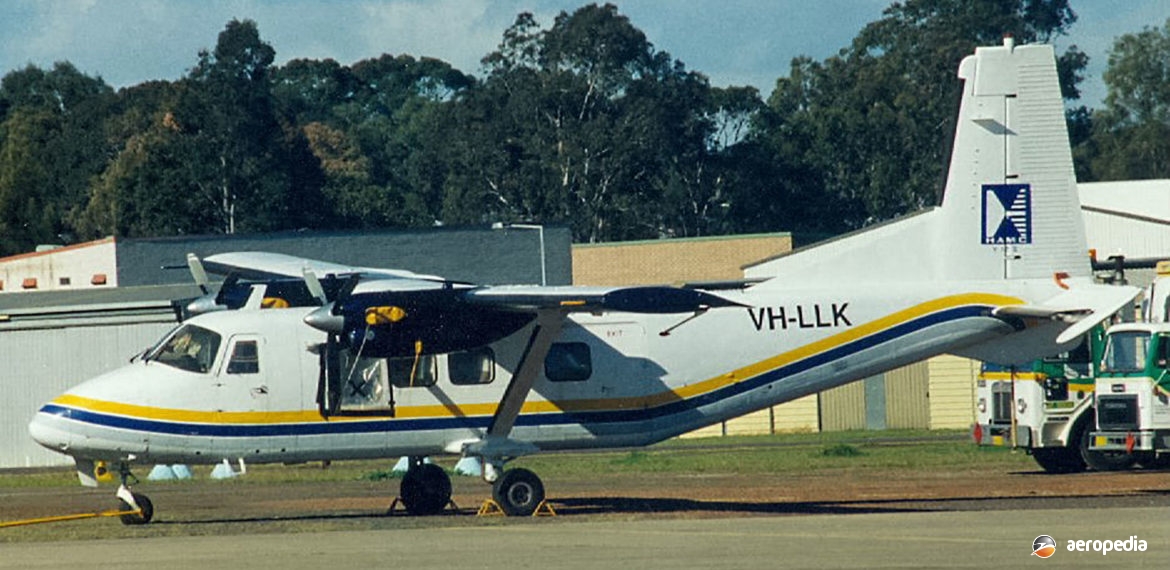Photograph:
Harbin Y-12 VH-LLK² (c/n 0048) at Bankstown, NSW in July 2003 (David C Eyre)
Country of origin:
People’s Republic of China
Description:
Light commercial airliner and utility transport
Power Plant:
Two 507 kw (680 shp) Pratt & Whitney Canada PT6A-27 turboprops
Specifications:
- Wingspan: 17.23 m (56 ft 6½ in)
- Length: 14.86 m (48 ft 9 in)
- Height: 5.575 m (18 ft 3½ in)
- Wing area: 34.27 m² (368.88 sq ft)
- Max cruising speed at 3,000 m (9,840 ft): 292 km/h (181 mph)
- Economical cruising speed at 3,000 m (9,840 m): 250 km/h (155 mph)
- Service ceiling: 7,000 m (22,960 ft)
- Max rate of climb at sea level: 504 m/min (1,655 ft/min)
- Range at 250 km/h (155 mph) at 3,000 m (9,840 ft) with max fuel and 45 mins reserve: 1,340 km (832 miles)
- Empty weight: 3,000 kg (6,614 lb)
- Max payload weight: 1,700 kg (3,748 lb)
- Loaded weight: 5,300 kg (11,684 lb)
History:
The Harbin Y-12 was a development of the piston engined C-11 built in some numbers by the State Aircraft Factory of the Chinese People’s Republic at Shenyang. It was a light utility transport of all-metal construction with a high-wing and was designed and built to replace the Shijiazhuang Y-5 in the utility role in China, this being a licence-built variant of the Antonov An-2 Colt. It was of simple construction and had high-lift devices to give it STOL capability, including leading-edge fixed slats inboard and automatic slats outboard, and trailing-edge drooping ailerons outboard of the double-slotted flaps. It had two 213 kw (285 hp) Zhuzhou Huosai 6A radial engines. However, it was unable to maintain height on one engine and the Y-11B appeared later with United States-built turbocharged engines, the first of this model flying in December 1990.
The Harbin Y-12 was then developed to take turboprop power, being fitted with two Pratt & Whitney Canada PT6A turboprops, becoming the Y-12 I, and had a wider and longer fuselage to increase the payload. The first of three prototypes flew in July 1982 powered by Chinese licence-built 373 kw (500 shp) Pratt & Whitney PT6A-10 turboprops, becoming the prototype of the Y-12 Series I.
Subsequently the Series II was developed, fitted with 507 kw (680 shp) PT6A-27 engines, flying for the first time on 16 August 1984. This model had a small ventral fin and a revised wing without the leading-edge slats, and received certification in the United Kingdom in 1990.
Further development led to the Y-12 IV, which first flew on 30 August 1984, and which had modifications to the wing tips and undercarriage, the cabin being able to accommodate up to 19 passengers.
The type has been obtained by a number of civil and military operators, including Flying Dragon Air Services, the Sri Lankan Air Force, Lao Aviation in Laos, and Pacific Air Charter.
In civil guise the Series II had a crew of two and accommodation for up to 17 passengers, but it could also be used as a VIP transport, for cargo, parachuting, geological survey, and maritime surveillance.
A couple of examples have been operated in this region. One DQ-FHF (c/n 0047 – ex B531L) visited Australia in February 1997 to attend the Australian International Air Show at Avalon, VIC. In 2001 a further example, a Harbin Y-12 II DQ-FSC (c/n 0048) arrived in Sydney, NSW and underwent certification at Bankstown, NSW becoming VH-LLK² on 27 April 2001 and entering service with Aviex Pty Ltd of Condell Park, NSW. It was used for some charter work but was exported as DQ-FSC on 25 October 2004.
In June 2005 a further example T3-ATI arrived in Cairns, QLD for maintenance by Hawker Pacific, this aircraft being operated by Air Kiribati. In March 2006 two examples arrived in Fiji for Air Fiji, becoming DQ-AFR (c/n 013 – ex N744L) and DQ-AFS (c/n 015 – ex N745L); and in December 2008 Air Vanuatu took delivery of two at Port Vila, these being registered B977L and B978L for the ferry flight.
Further examples have been imported to Fiji, becoming YJ-AV4 (c/n 028 -ex YJ-78L), YJ-AV5 (c/nb 029) and YJ-AV6 (c/n 032), one of which struck the terminal building at Matei on 12 October 2008 when the brakes failed, receiving extensive damage.
In November 2014 the Hong Kong based Southern China Morning Post newspaper reported Coptervision in California had ordered 16 Y-12Es and four Y-12Fs. The latter was a new model with a wider fuselage able to accommodate three LD-3 containers, a new wing, a retractable undercarriage in lieu of the fixed unit, and uprated PT6A-65B turboprop engines. Accommodation for passengers was increased from 17 to 19 making the aircraft a competitor for the Dornier Do-228 and the new Viking Twin Otter.
Also in 2014 a number of Y-12s were operating with South Pacific island airlines and many developing Asian countries.

